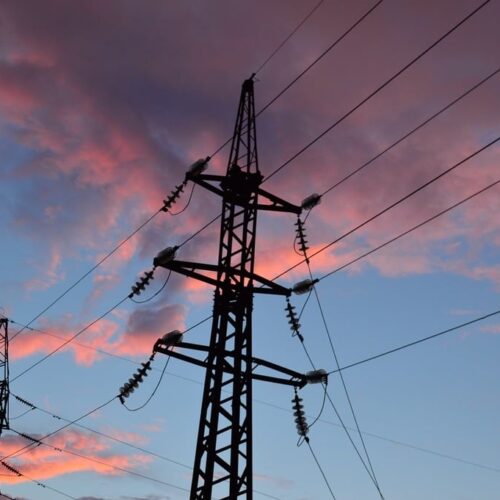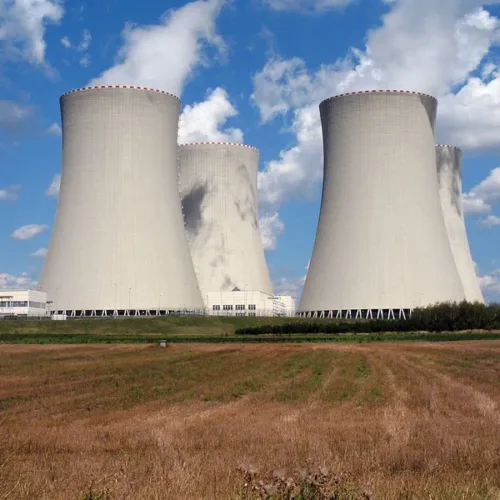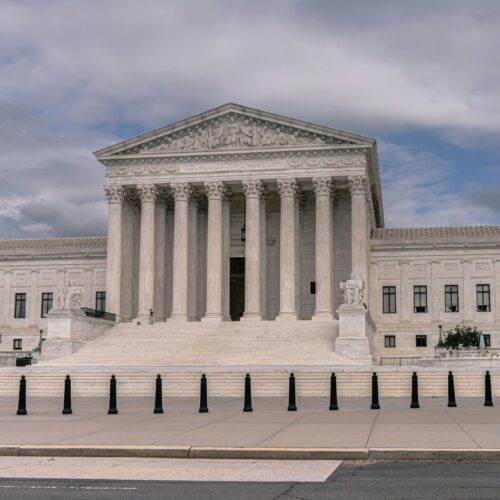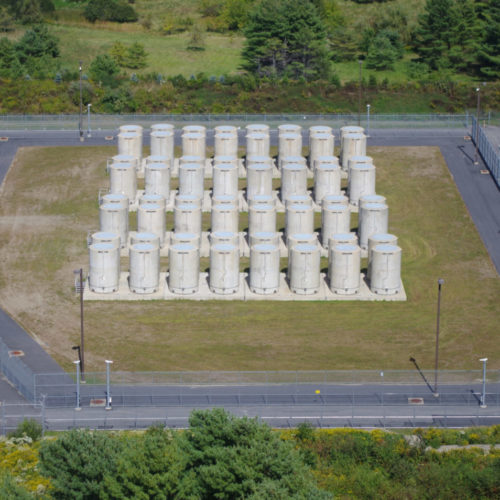Embracing the public on a nuclear waste storage solution
This article appears in the 2016-2017 edition of Perspectives.

Dry cask storage at the site of the former Maine Yankee plant in Wiscasset, Maine. Photo courtesy of Maine Yankee.
During the first half of 2016, U.S. federal energy officials sat down with residents of communities across the country to have a frank discussion about the fate of the nation’s growing stockpile of nuclear waste.
They gathered in hotel conference rooms from Boston to Sacramento, in meetings that often stretched for several hours, and considered a new effort to find a long-term resting place for spent nuclear fuel—one that will hinge on public support to move forward.
The initiative represents a stark departure from the top-down siting model that resulted in the federal government’s designation in 2002 of Yucca Mountain, in Nevada, as a long-term repository. That decision led to a backlash among local residents and others, and eventually to rejection of the site seven years later.
The new approach, known as “consent-based siting,” requires staff from the U.S. Department of Energy (DOE) to reach out to communities and local governments, and ask them to explore whether they might be willing to host a facility. Similar programs are advancing in Canada and Europe. The hope is that through sustained public education and engagement, the initiative will succeed where previous efforts have failed: in garnering local acceptance and support for an underground site to safely store highly radioactive waste for millennia.
“The effort at Yucca Mountain made clear that building a repository in a community or state that did not agree to host one was not workable,” said DOE Secretary Ernest Moniz in a video address shown at each meeting. “We hope to hear from you about what a fair and open consent-based siting process should look like.”
Building trust
During the gatherings—eight in all—staff heard a flurry of concerns related to safety and fairness. They assured skeptics that it was possible to isolate the waste in a way that would not impact humans or the environment for generations to come. Perhaps more than anything else, community leaders wanted guarantees that the process would be transparent.
“There is a level of distrust when it comes to tribes and the federal government,” said George Gholson, chairman of the Timbisha Shoshone Tribe in Death Valley, California, during a panel discussion with DOE staff, nuclear engineers, academics, local officials, and residents at a meeting in Tempe, Arizona.
“I think the general public needs to know what they are consenting to,” he said. “What types of materials? What types of dangers? What types of containers? How it’s being transported? We need to be educated on what we are consenting to, or we’re consenting in ignorance.”
Uldis Vanags, project director of CSG/ERC’s affiliate organization, the Northeast High-Level Radioactive Waste Transport Project, is accustomed to hearing about safety concerns from the public. For two decades, the task force has collaborated with federal, state, and local officials in 10 northeastern states to develop a plan to smoothly and safely transport spent fuel along the region’s roads and railways. If, and when, officials designate an interim storage site or a long-term repository, the task force will play a critical coordinating role. Getting buy-in from communities along waste shipment routes is critical, he said.
“The trust issue is key: that’s what’s driving this whole consent-based process,” said Vanags, who attended a DOE meeting in Boston. “DOE realized that they did not have the trust of the public or of the state officials and towns, and that they needed to build a relationship and just be completely open.”
Unintended consequences
The challenge of finding a willing host for the nation’s nuclear waste has been around since the first U.S. reactor went online more than six decades ago. Currently, some 75,000 metric tonnes of spent fuel are stored in pools or dry casks in 33 states. The waste is located at operating commercial reactors and at plants that have been shut down, decommissioned, and no longer even have a reactor—all that’s left is the spent fuel. There is also high-level waste left over from the nuclear weapons program in need of a permanent storage site.
The burden of temporarily storing waste in multiple sites is costing taxpayers billions, and some plant owners want to be rid of the responsibility altogether. And the problem is only growing: the 99 operational commercial nuclear plants, which produce nearly 20 percent of the nation’s electricity, generate about 2,000 metric tonnes of spent fuel each year.
The federal government never intended to leave the waste scattered across the country indefinitely; in fact, spent-fuel storage pools at commercial nuclear power plants were designed to hold waste only for a few years. The 1954 Atomic Energy Act required that spent fuel from commercial reactors be shipped to a reprocessing plant and recycled into new fuel. But for a variety of reasons, commercial reprocessing never succeeded in this country.
In 1982, the Nuclear Waste Policy Act ordered the DOE to investigate a long-term geologic repository, and the federal Nuclear Waste Trust Fund has since collected $39 billion from nuclear utility customers to fund it; but since the rejection of the Yucca Mountain site in 2009, the future of the spent fuel has been uncertain.
Utilities are suing the DOE for the cost of stockpiling the waste at their reactors since 1998, the year that the agency defaulted on a contract to begin removing it from plants nationwide. The federal government has already paid out more than $4.5 billion in settlements and court judgments, an expense that is expected to cost $500 million a year going forward.
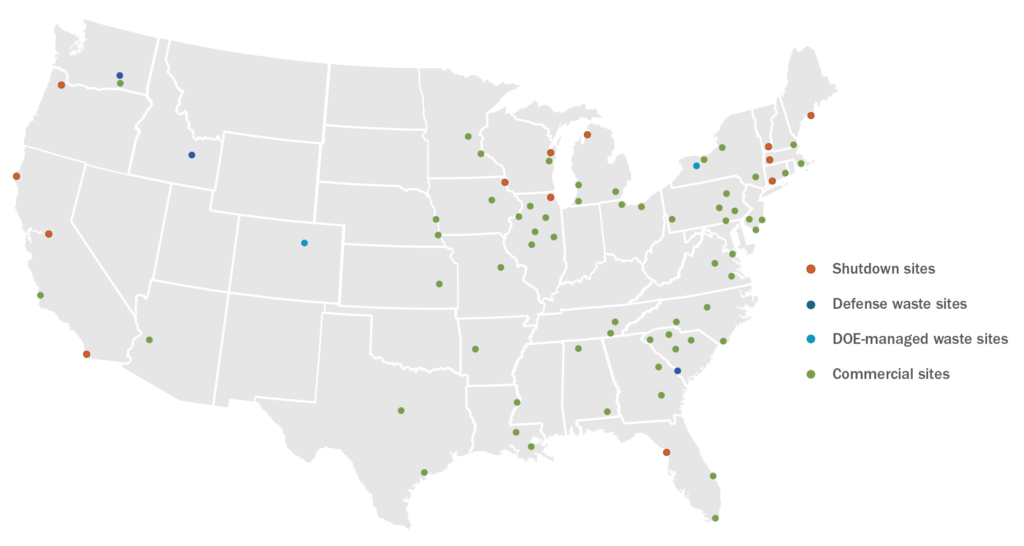
Approximate locations of the current sites where spent nuclear fuel and high-level radioactive waste are being stored in the United States. Credit: U.S. Department of Energy.
“So if we do nothing to act, the amount of waste is just going to continue to grow, and the communities that host these facilities, or DOE sites, will just become hosts to waste over the long term,” said John Kotek, acting assistant secretary for nuclear energy at the DOE, during the Tempe meeting.
In addition to the expense it generates, the waste prevents the sites of former plants—such as Maine Yankee, where the decommissioning process ended in 2005—from being put to better uses in the community. Just monitoring and safeguarding the leftover spent fuel stored there in dry casks costs taxpayers $8 million a year, and keeps the town of Wiscasset from being able to consider redevelopment, said Marge Kilkelly, senior policy adviser to U.S. Senator Angus King of Maine, during a meeting in Boston. Kilkelly is former deputy director of CSG/ERC.
The consent-based siting initiative is modeled after similar efforts in Canada, Sweden, France, and Finland, where officials worked with communities and local governments to help them explore whether they wanted to host a facility. Finland is the farthest along—officials have identified a site with the support of the local community. Regulators have approved the application, and construction of the repository is supposed to start later this year, said Kotek.
Consent-based siting was a key proposal that emerged from the Blue Ribbon Commission on America’s Nuclear Future, a group of independent experts formed by President Obama in 2010 to devise a new strategy for permanent storage. The commission released a report in 2012 that contains a series of recommendations that form the basis of the Obama administration’s strategy. They include development of a pilot project to begin removing spent fuel from decommissioned nuclear plants by 2021, and a dependable transportation system to move the materials—by rail, barge, and truck.
Vanags’ task force has long worked with community leaders in the Northeast who would be responsible for overseeing waste shipments in their jurisdictions. Once a storage site has been designated, it will trigger a planning effort that is expected to take up to five years to prepare.
When spent fuel is sent across a state, every town along the route must have first responders and other public safety experts on hand in case of emergency. Having enough qualified staff costs money. The Nuclear Waste Policy Act provides states with funding to train emergency personnel, but it doesn’t cover so-called operational costs, which vary by state and can be critical to maintaining safety. Bills have been introduced in Congress to revise the law and include money to cover operational costs, but their fate is uncertain.
In 2015, Vanags helped supervise a multistate training exercise—the first of its kind—intended to help states get a handle on their funding needs to secure enough equipment, inspectors, and training for the flood of individuals who would provide first-responder emergency services along shipment routes. The effort was organized by the DOE and drew participants from eight states, including Pennsylvania and Connecticut in the Northeast.
After the exercise, officials completed an application for cooperative funds from the DOE. Each grant request was evaluated by a review panel composed of agency staff, who offered feedback. The grants would help cover the costs of transporting waste during a program’s first two years. The application was complex and time-consuming, and the DOE is now working with state and local officials to simplify the process, said Vanags.
The need for interim storage
DOE staff received some 10,000 public comments on the consent-based siting initiative, and the agency expects to release a final report in December 2016. But the future of the initiative is unclear, given the impending administration change. And although some members of Congress favor starting a new search for a site to house the nation’s waste for the next 10,000 years, others would like to revive Yucca Mountain as a national repository. Some $15 billion has already been invested in Yucca Mountain, and the Nuclear Regulatory Commission is in the final stages of completing the licensing review for the site, even though the program was defunded in 2009.
Even if Yucca Mountain were back on the table, it would be decades before shipments could begin, said Vanags. And if the project remains dead, he estimates that it would take 40 years to identify a new repository and begin sending waste there. “So there is going to have to be an interim storage site,” he said.
The good news is that the federal government already has significant experience transporting spent nuclear fuel in this country. Kotek of the DOE said that Idaho has received hundreds of shipments over the years from both the Navy and other DOE activities, and from university research reactors in the United States and even abroad.
Recently, local officials in Texas and New Mexico expressed interest in hosting interim storage sites run by private companies that would store spent fuel from reactors that have been shut down, and one state is in the process of requesting licensing from the Nuclear Regulatory Commission. If the project moves forward, the state may be able to accept waste as soon as 2021.
That may seem like a long way off, but it takes years of preparation to work through the myriad funding, safety, and logistical hurdles involved in moving vast quantities of high-level waste through a state, said Vanags. Earlier this year, Vanags and Vermont state officials visited the site of the former Vermont Yankee Station, which shut down in 2014. The group examined the condition of the existing rail infrastructure, which will be used to remove the spent nuclear fuel from the plant once an interim storage site has been established.
The communities in Texas and New Mexico reportedly have the support of the public, and the process they followed could serve as an example for consent-based siting elsewhere, said Vanags.
DOE officials are hopeful that by educating people about the risks and benefits, they can follow in the footsteps of other countries that are moving ahead with consent-based siting.
“There’s a scientific consensus around the globe that this stuff can be safely managed and disposed [of] for the long term,” Kotek told participants in the Boston meeting. “Let’s get on with it.”
